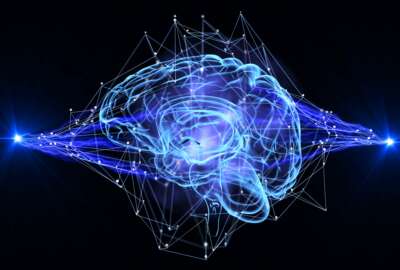Now a big national laboratory has gone all in on artificial intelligence
Artificial intelligence has grown too big for anyone to ignore. Now the Pacific Northwest National Laboratory, in south-central Washington state, has established a...
Artificial intelligence has grown too big for anyone to ignore. Now the Pacific Northwest National Laboratory, in south-central Washington state, has established a center for artificial intelligence. To find out more about it, the Federal Drive with Tom Temin spoke with the lab’s chief scientist for artificial intelligence, Dr. Court Corley.
Interview Transcript:
Tom Temin And we didn’t mean to imply that you’ve been ignoring it until now in just getting into it, but a special center for it. Tell us why that’s happening now.
Court Corley Sure. The Department of Energy’s national laboratories are a crown jewel of science and technology development for the United States and have been for quite some time. We’re a Department of Energy Office of Science stewarded laboratory, which means that we have been developing analytics and science and service of the nation for quite some time, decades, in fact. What’s different today is that as we’re seeing all throughout business and industry and government, that AI is really having a significant impact across the range of missions that we have. At the laboratory, we have missions in scientific discovery, energy sustainability and national security. And just by a factor of the size of our organization, there are roughly 6,000 staff, about two-thirds of those are scientists or engineers just in our own laboratory, which is one of many national laboratories in the nation. Because of how we’re organized, we have pockets of AI research, AI application, scientific discovery, AI engineering, and all the things in between that are really incredible work. But what we need to do now and why we created the center, is really to help us aggregate that collective experience, be able to drive impact, elevate priorities, and really go after some really global challenges that are facing us.
Tom Temin So then the center is a way to make sure that there is no duplication of effort. Or will you actually do artificial intelligence research within the center itself?
Court Corley So we’ll do a couple different things. Absolutely. We will be driving AI research and really pursuing the areas that are going to help us advance AI and our science, energy and security missions. And that’s going to be really exciting. In addition, we’re going to be applying AI and all the different areas that we’re working in. Specifically things like controlling the power grid. So right now our power generation and distribution is very intermittent. And the methods that are used today work. It’s amazing that our grid is up. But for the future, and with the increase of clean energy, new energy resources coming online, we need additional methods to really help us be able to manage that effectively for our nation. So that’s like one example of the types of things that we’ve been working on. So it’s both it’s driving research and it’s the application.
Tom Temin Yeah. You want to make sure everyone is not doing the same thing in six different places. And then you have waste effort. And just a detailed question on the grid because that is in private hands. And there are quasi regulatory bodies that make sure the grid is managed in a way that one region can communicate with the other, these reliability councils and so forth. What is going on with respect to AI? Where can AI, so far as we know now, help in grid reliability and distribution of electricity and all those things.
Court Corley So one of the roles that the national labs play in general is really in providing tools. We won’t be the ones that operate the grid. We won’t be the ones that control it. But everything from intermittent generation based on renewables, that’s a need for better types of control, battery design for better batteries and energy storage for the intermittent generation. So those are areas where we can build tools and capabilities that we can then partner with our regional utilities and otherwise to support and distribute those.
Tom Temin And do you think it’s possible maybe that I mean, utilities have really good data on demand by the hour and demand by the minute. And so they can tailor their operations to what they know is going to happen, like a heat wave is coming or something. Can, AI enhance that, make it more fine grained? Especially, as you say, with intermittent generation, which is a nice way of saying the sun doesn’t always shine and you don’t want things to happen to blackout because we love solar energy.
Court Corley Absolutely. So kind of taking a step back and looking at what the needs are in artificial intelligence right now. We do have a need to do sub meter resolution forecasting for weather. And today that is such a challenge to do that with our current methods. We do a decent job. But I believe that the new class of AI that’s coming online, the frontier AI that we see commercial gains from it, ChatGPT, you have to say that. But what does it mean for the sciences and for energy is equally compelling. Andrew Ng in 2017, said AI is the new electricity because it’s going to touch everything that we do and I do believe it’s going to help us at the large scale where we do need tens of thousands of GPUs to train a model. That is the place where DOE traditionally has excelled with the exascale computing program and so forth.
Tom Temin We’re speaking with Dr. Court Corley. He is the chief scientist for artificial intelligence in the AI and data analytics division at the Pacific Northwest National Laboratory. And you bring up a good point in trying to understand energy issues. AI consumes tons of energy. There’s even published pieces on how much energy it could consume, almost like Bitcoin mining. We need data fields and so forth for this. And you’ve been following AI for a long time. What is the future of AI to maybe solve its own energy consumption needs? Is that even something people are thinking about?
Court Corley So I think there’s a couple of different solutions that we have to address as a nation. One, the energy consumption is astounding. Renewables and clean energy is the way to go about that. And I think the investment of the nation of if we set a goal, let’s say we set a goal of achieving clean energy by 2035. How are we going to do that? Well, we need to focus on things like energy efficient electricity, energy efficient GPUs, energy efficient AI training, energy efficient methods. And even in the past six months, there’s been advances in AI research that shows you can have exceptional gains by building smaller models that are still just as worthwhile, but they’re domain specific. And so perhaps there’s a way that we can develop maybe more energy efficient methods that are going to help us in the long run, reduce energy consumption. Because right now, yes, you are correct that the energy needs are quite astounding for these large systems.
Tom Temin And have you found two that you don’t necessarily need limitless data sets for every application? But maybe you get better training with more limited data sets and therefore less consumption?
Court Corley Absolutely. So there’s one approach in the realm of scientific machine learning, where we really constrain the models by the known laws of physics. We say these are the laws of conservation. And by incorporating those into the models themselves. Absolutely. We need less data, we need less compute. They become more understandable, which is really what we need for something that is so critical and in a high consequence system, something that is going to behave in a way that is safe and secure and reliable. And by adding in physics, that’s one way that we can do that to reduce the complexity within the system.
Tom Temin And are there models to going to the large end of things where you would bring econometrics into energy modeling? For example, we could have clean energy tonight, except the economy would collapse and everyone would starve to death. So we don’t want that either, because every gallon of gas, every cubic meter of natural gas that’s consumed is someone pursuing their life’s goals and their occupation. And so is that something people are looking at is to have some kind of grand design, so we could get better answers on how all of this can work.
Court Corley So it is a tough challenge. And for myself in our organization, we don’t have economists necessarily on staff, but those are really critical questions that the nation is going to have to answer. One of the ways that we get around that, though, is through partnerships. As a national lab, we love our partnerships and rely on them to build complementary expertise and the things that we work on. One of the efforts we work on is with the other Office of Science and other national labs. For example, there’s a new consortium called the Trillion Parameter Consortium that Argonne National Labs launched with Oak Ridge. And I think now there’s 100 different joining us on it. And it’s really about building models for science and energy in a way that it has to support the nation. And in those settings, I imagine because there’s university partners, there’s other entities involved. Absolutely, those types of considerations would be able to be considered.
Tom Temin Because from the PNNL standpoint, there are many domains really that go into energy. You mentioned batteries. Well, that’s physics and chemistry and the grid of materials. So really if you break down any of these domains, nothing is existing by itself.
Court Corley Absolutely. And one of the benefits of being at PNNL is we have amazing chemists and physicists and electrical engineers and computer scientists. And we’re able to bring all of these individuals together in a way that is compelling to address a lot of these grand challenges. And where we don’t, we partner and we work with universities and other institutions as well.
Tom Temin And just getting back to the center for AI there at the PNNL, who populates it? Are you drawing in people that were in other areas of PNNL doing AI or bringing in new people? What are some of the functions?
Court Corley Sure. So the functions itself, absolutely. It’s meant to be both a benefit to the outside and have a way for folks to see what we’re doing in AI, but also internally, we do have members from across what we call directorates. But that’s the way we’re organized. Today there’s roughly one fifth of our scientists and engineers that are using machine learning in their work or artificial intelligence. And so all of these folks are associated with the center. And by doing so, they get access to resources, they get access to our own internal infrastructure. We also partner with hyperscalers and other organizations to be able to provide the infrastructure that’s needed to do machine learning and etc. In addition to that, we’re really all about workforce development and mentoring and bringing up the next cadre of workforce to really continue to grow the number of folks that are engaged in the application or the development of new AI that’s going to really drive our science, energy and security forward.
Tom Temin And as someone who has degrees and PhDs in artificial intelligence, it’s not a new field. But do you personally get the sense that suddenly the world has caught up to you and now this is the real deal?
Court Corley So I am super excited. I use machine learning in my PhD dissertation. It wasn’t very good, but it did the job. And it continues to only get better. Now, we have methods that scale to infinite amounts of data. And we do need better methods that are more efficient. But I do believe there’s a fundamental change in how we go about doing things. Yet there is still more work to be done. I will say that while we’ve seen decent success for specific applications like in chat, there really does need to be more research and investment into understanding how can we use these things for understanding biological function, for understanding materials so we can have more robust compounds for space missions, so to say. There’s really all kinds of applications for these areas that are really important. And I do believe that machine learning in AI today is going to get us a lot further, but there’s still a lot more work to be done. By no means is it a one size fits all tool. And as anybody that’s used any of the open tools will tell you, like they still make errors. There’s a lot of concern about making sure it’s safe, secure, trustworthy that we develop these methods ethically.
Copyright © 2025 Federal News Network. All rights reserved. This website is not intended for users located within the European Economic Area.
Tom Temin is host of the Federal Drive and has been providing insight on federal technology and management issues for more than 30 years.
Follow @tteminWFED






